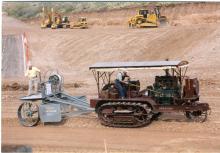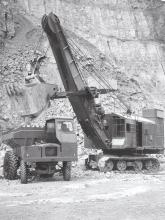
Not all bulldozers feature mechanical drivelines as Mike Woof reports
As an earthstripping tool the bulldozer can an extremely efficient machine in the right application. The first bulldozers were animal-driven and were used for roadworks at the end of the 19th century.
When the crawler tractor was developed by
Although the very first crawler tractors from Holt (as well as Hornsby in the UK) were steam driven, crawler tractors quickly switched to the lighter and more powerful petrol (gasoline) engine. By the time bulldozer blades were fitted to crawler tractors, these machines were all petrol powered.
Drive to the main sprockets was through conventional mechanical means using gearboxes.
When the early diesel bulldozers appeared, with
But other alternative driveline systems have also been used in bulldozers.
Other firms have since followed Liebherr’s pioneering lead, with even Caterpillar having developed a hydrostatic drive bulldozer in the shape of its D6K model.
Caterpillar has also made another novel step, introducing the D7E bulldozer with electric drive. This features a diesel engine coupled to a generator that powers the AC electric motors at the rear. But it is worth noting that while this is the first bulldozer to feature AC motor drives, it is by no means the first diesel electric bulldozer.
Russian firm Chetra offered a diesel electric bulldozer for many years. The firm’s Model A-384 weighed in at 34tonnes and its design allowed the comparatively large cab to be mid-mounted, which offered good forward visibility for the time.
And in 1962 what was then the world’s largest bulldozer, the 90tonne XDE80, was built around the chassis of two Euclid TC-12 crawler tractors. These chassis were modified with electric drives and were powered with twin
It is worth noting though that using an internal combustion engine to drive a generator with electric motors then providing drive is an older concept still. This drivetrain system was first used by (Dr) Ferdinand Porsche in a car he designed for the Austrian firm Lohner in 1901, a system he patented.
Various cars, buses and trucks were built throughout the 20th century that featured petrol engines coupled to generators, and used electric motors to power the wheels.
In WWII the German Elefant tank destroyer was also built, which used a Porsche-developed electric drive to power its tracks.









